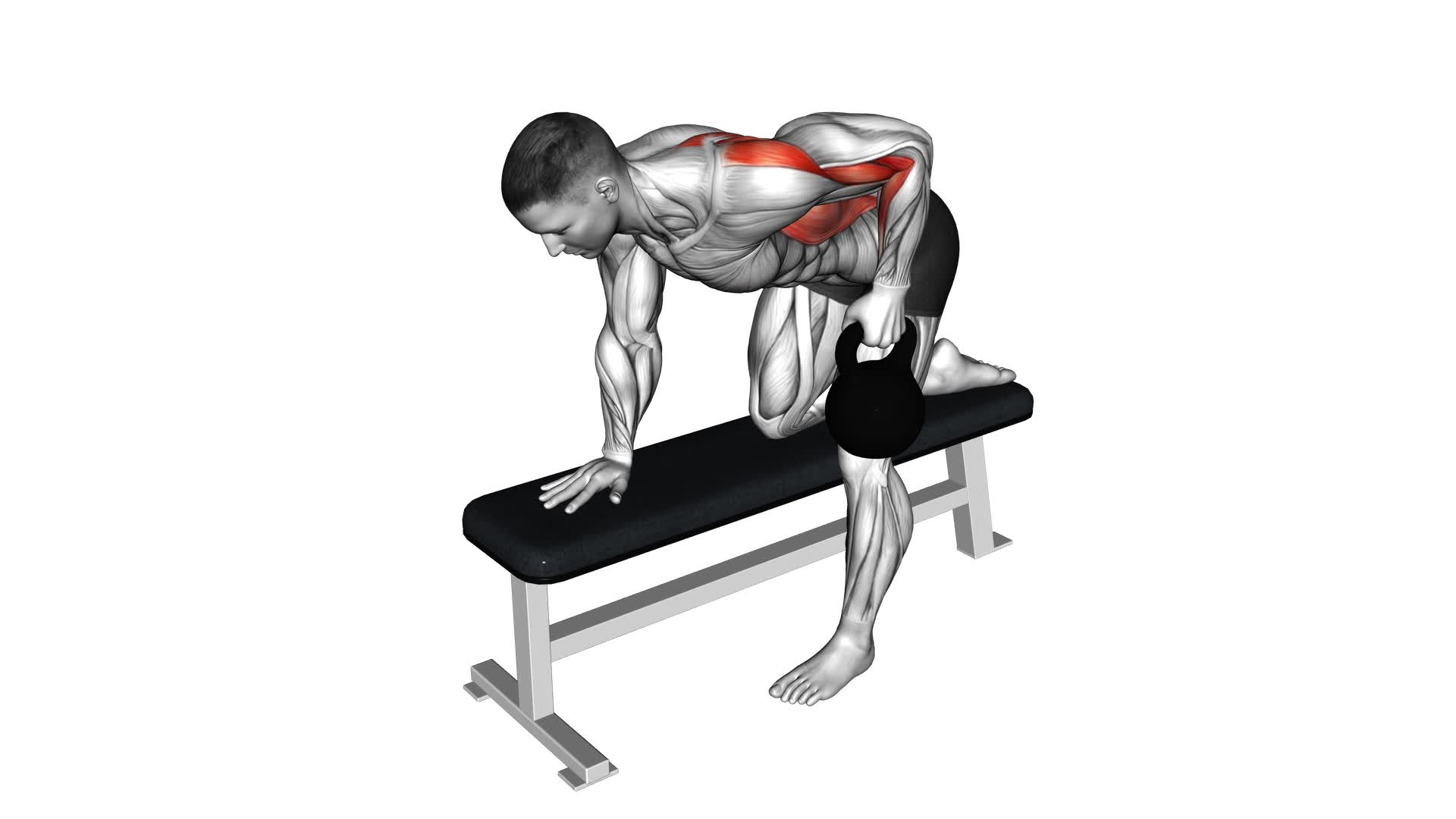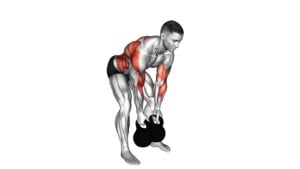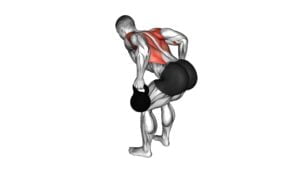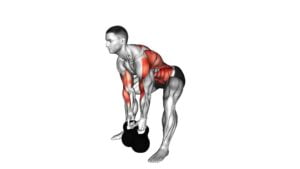Kettlebell Bent-over Row – Video Exercise Guide & Tips

Are you looking for an effective exercise to target your back muscles? Look no further than the kettlebell bent-over row.
Watch This Exercise Video
This video exercise guide will show you the proper form and technique to perform this exercise efficiently. Whether you're a beginner or an advanced user, we've got modifications to suit your fitness level.
Avoid common mistakes and maximize your results with these helpful tips. Get ready to strengthen your back and improve your overall fitness.
Let's get started!
Key Takeaways
- Targets multiple muscle groups simultaneously, including the back, shoulders, and arms
- Enhances upper body strength and develops a more toned and defined physique
- Improves posture by strengthening the muscles responsible for proper spine alignment
- Alleviates back pain and prevents future injuries
Benefits of the Kettlebell Bent-over Row
Improve your strength and posture with the Kettlebell Bent-over Row. This exercise offers numerous benefits for your overall fitness. One of the main advantages is that it targets multiple muscle groups simultaneously, including your back, shoulders, and arms. By performing this exercise regularly, you can enhance your upper body strength and develop a more toned and defined physique. Additionally, the Kettlebell Bent-over Row helps to improve your posture by strengthening the muscles responsible for maintaining proper alignment of your spine. This can alleviate back pain and prevent future injuries.
Another benefit of the Kettlebell Bent-over Row is its versatility. You can easily modify the exercise to suit your fitness level and goals. For beginners, using a lighter kettlebell or starting with bodyweight-only variations can help build a solid foundation before progressing to heavier weights. On the other hand, advanced practitioners can challenge themselves by increasing the weight or adding variations such as single-arm or alternating rows.
As we transition into discussing the equipment needed for the exercise, it's important to note that the Kettlebell Bent-over Row can be performed with just a kettlebell. This makes it a convenient exercise that can be done at home or in the gym.
Equipment Needed for the Exercise
To perform the Kettlebell Bent-over Row, all you need is a kettlebell. This exercise is a great addition to your kettlebell exercises routine and can help strengthen your back and upper body.
Here are the three key pieces of workout equipment you'll need for this exercise:
- Kettlebell: Choose a kettlebell that suits your fitness level. Start with a weight that feels challenging but manageable. As you progress, you can gradually increase the weight to continue challenging your muscles.
- Comfortable workout clothes: Wear comfortable clothing that allows for a full range of motion. Opt for breathable fabrics that wick away sweat to keep you cool and dry during your workout.
- Proper footwear: Invest in a pair of supportive athletic shoes that provide stability and cushioning. This will help protect your feet and joints while performing the Kettlebell Bent-over Row.
By having these essential workout equipment items, you'll be ready to perform the Kettlebell Bent-over Row and maximize the benefits of this exercise for your back and upper body strength.
Proper Form and Technique
To perform the kettlebell bent-over row with proper form and technique, it's crucial to maintain a correct back positioning and engage your core. Keep your back straight and avoid rounding or arching it.
Engaging your core will provide stability and support throughout the exercise, helping you maintain proper form and prevent injury.
Correct Back Positioning
Maintain a strong and stable back position throughout the kettlebell bent-over row exercise. Proper back posture and spinal alignment are essential to prevent injuries and maximize the effectiveness of this exercise. Here's how you can ensure correct back positioning:
- Stand with your feet shoulder-width apart and hinge at the hips, keeping your back straight.
- Engage your core muscles to support your spine and maintain stability.
- Keep your shoulders down and back, avoiding any rounding or excessive arching of the back.
By maintaining a strong and stable back position, you not only protect your spine but also optimize the engagement of your back muscles during the kettlebell bent-over row.
Now, let's move on to the next important aspect of this exercise: engaging the core.
Engaging the Core
Engage your core muscles to stabilize your body and support proper form during the kettlebell bent-over row exercise. Core stability is essential for maintaining a strong and balanced position throughout the movement. As you hinge forward at the hips, focus on activating your abdominal muscles to create a solid foundation. By engaging your core, you can prevent excessive arching or rounding of the spine, which can lead to injury.
Imagine pulling your belly button towards your spine and maintaining this engagement throughout the exercise. This won't only protect your back but also enhance the effectiveness of the rowing movement. Remember, proper abdominal engagement is key to maintaining a stable and strong posture during the kettlebell bent-over row.
Modifications for Beginners and Advanced Users
If you're a beginner or an advanced user, you can modify the kettlebell bent-over row exercise to suit your fitness level. Here are some modifications to consider:
- Beginner Modifications:
- Start with a lighter kettlebell or even a dumbbell to build strength and improve your form.
- Perform the exercise with your knees slightly bent to reduce strain on your lower back.
- Focus on mastering the technique before increasing the weight or intensity.
- Advanced Modifications:
- Increase the weight of the kettlebell to challenge your muscles and continue making progress.
- Perform single-arm bent-over rows to engage your core and improve stability.
- Incorporate a pause at the top of the movement to increase time under tension and enhance muscle activation.
By modifying the kettlebell bent-over row exercise, you can tailor it to your current fitness level and gradually progress as you become stronger.
Now, let's move on to the next section and discuss some common mistakes to avoid during this exercise.
Common Mistakes to Avoid
When performing the kettlebell bent-over row, it's important to be mindful of common mistakes that can hinder your form and effectiveness.
One common mistake to avoid is shoulder rounding, which can lead to poor posture and strain on the shoulders.
Another mistake to watch out for is improper hip hinge form, as this can put unnecessary stress on the lower back.
Shoulder Rounding Correction
To correct shoulder rounding during the kettlebell bent-over row exercise, ensure that you maintain a straight and aligned posture throughout the movement. Here are three key techniques to help improve your shoulder mobility and correct shoulder rounding:
- Stretching exercises: Incorporate shoulder mobility exercises into your warm-up routine. These can include arm circles, shoulder shrugs, and band pull-aparts. These exercises help to loosen up tight muscles and improve your range of motion.
- Strengthening exercises: Perform exercises that target the muscles responsible for good posture, such as the upper back and shoulder muscles. Some examples include rows, pull-ups, and face pulls. Strengthening these muscles will help prevent shoulder rounding during the kettlebell bent-over row.
- Posture improvement techniques: Pay attention to your posture throughout the day, not just during your workouts. Stand tall, pull your shoulder blades back and down, and engage your core. Practicing good posture will reinforce proper alignment during the kettlebell bent-over row exercise.
Proper Hip Hinge Form
Maintaining a proper hip hinge form is crucial for maximizing the effectiveness of the kettlebell bent-over row exercise and avoiding common mistakes.
The hip hinge is a fundamental movement pattern that involves bending at the hips while keeping a neutral spine. This form not only allows you to target your back muscles more effectively but also helps to minimize strain on your lower back.
By hinging at the hips, you engage your glutes and hamstrings, which provide stability and power throughout the movement. To ensure a correct hip hinge, focus on pushing your hips back, keeping your chest up, and maintaining a slight bend in your knees.
Additionally, you can modify the hip hinge by using lighter kettlebells or adjusting your stance width.
Now that you understand the importance of proper hip hinge form, let's move on to some tips for maximizing your results.
Tips for Maximizing Your Results
To maximize your results with the kettlebell bent-over row, focus on proper form and engage your core throughout the exercise. Here are some tips to help you maximize gains and optimize your workouts:
- Maintain a neutral spine: Keep your back straight and avoid rounding or arching your back. This will help prevent injury and ensure that you're targeting the right muscles.
- Squeeze your shoulder blades: As you pull the kettlebell towards your body, focus on squeezing your shoulder blades together. This will engage your upper back muscles and promote better posture.
- Control the movement: Slow and controlled movements are key to maximizing the effectiveness of the exercise. Avoid using momentum to lift the kettlebell and instead, focus on using your back muscles to perform the rowing motion.
By following these tips, you'll be able to optimize your kettlebell bent-over row workouts and achieve better results.
Remember to start with a weight that challenges you but allows you to maintain proper form, and gradually increase the weight as you get stronger. Keep pushing yourself and stay consistent to see the best results.
Frequently Asked Questions
How Many Repetitions Should I Do for the Kettlebell Bent-Over Row?
To get the most out of the kettlebell bent-over row, it's important to consider repetition recommendations and proper form.
When it comes to the number of repetitions, it's best to start with a weight that challenges you and aim for 8-12 reps per set. This will help build strength and muscle endurance.
Remember to maintain a flat back, engage your core, and squeeze your shoulder blades together throughout the exercise for proper form.
Can the Kettlebell Bent-Over Row Help With Improving Posture?
Yes, the kettlebell bent-over row can help improve your posture. By targeting the muscles in your upper back and shoulders, this exercise strengthens the muscles responsible for maintaining proper alignment.
The bent-over position also activates your core, promoting stability and balance.
Incorporating kettlebell exercises into your workout routine has numerous benefits, including improved posture, increased strength, and enhanced overall fitness.
Is It Necessary to Use a Kettlebell for the Bent-Over Row, or Can I Use Other Weights?
Using dumbbells instead of kettlebells for the bent-over row is definitely an option. However, it's worth noting that kettlebell exercises offer unique benefits for overall strength and muscle growth.
Kettlebells engage multiple muscle groups and challenge your stability and core strength.
Can the Kettlebell Bent-Over Row Help With Strengthening the Lower Back?
Yes, the kettlebell bent-over row can definitely help with strengthening your lower back. This exercise targets the muscles in your back, including the lower back, and helps to build strength and stability.
Kettlebell exercises offer a unique advantage due to their shape and the need to stabilize the weight, which can further engage your core and lower back muscles.
Are There Any Specific Warm-Up Exercises Recommended Before Performing the Kettlebell Bent-Over Row?
Before performing the kettlebell bent-over row, it's important to do specific warm-up exercises. These exercises help prepare your body for the workout and reduce the risk of injury.
Warm-up exercises increase blood flow to your muscles, improve flexibility, and enhance overall performance. They can include dynamic stretches, light cardio exercises, and activation exercises for the muscles you'll be targeting during the row.
Incorporating warm-up exercises into your routine will maximize the benefits of your workout.
Conclusion
In conclusion, the kettlebell bent-over row is a highly beneficial exercise that targets multiple muscle groups in the upper body.
By using proper form and technique, you can maximize your results and avoid common mistakes.
Whether you're a beginner or an advanced user, there are modifications available to suit your fitness level.
Incorporate this exercise into your routine and enjoy the benefits of improved strength and posture.

Author
Years ago, the spark of my life’s passion ignited in my mind the moment I stepped into the local gym for the first time. The inaugural bead of perspiration, the initial endeavor, the very first surge of endorphins, and a sense of pride that washed over me post-workout marked the beginning of my deep-seated interest in strength sports, fitness, and sports nutrition. This very curiosity blossomed rapidly into a profound fascination, propelling me to earn a Master’s degree in Physical Education from the Academy of Physical Education in Krakow, followed by a Sports Manager diploma from the Jagiellonian University. My journey of growth led me to gain more specialized qualifications, such as being a certified personal trainer with a focus on sports dietetics, a lifeguard, and an instructor for wellness and corrective gymnastics. Theoretical knowledge paired seamlessly with practical experience, reinforcing my belief that the transformation of individuals under my guidance was also a reflection of my personal growth. This belief holds true even today. Each day, I strive to push the boundaries and explore new realms. These realms gently elevate me to greater heights. The unique combination of passion for my field and the continuous quest for growth fuels my drive to break new ground.







